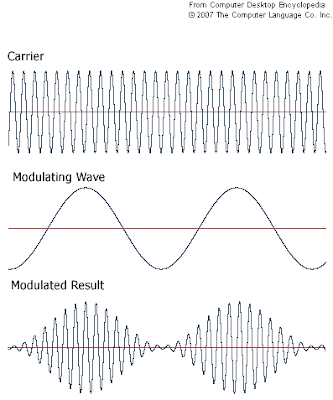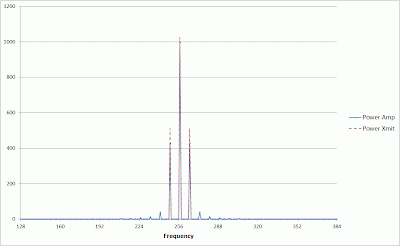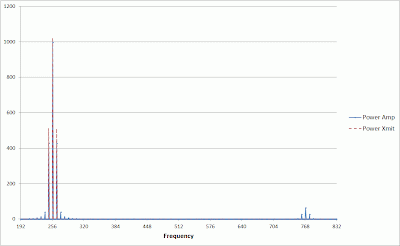A fundamental concept related to yesterday's book review is nonlinearity, which leads to unexpected effects, and not just in giant oceanic waves. I first need to define what a mathematician means by linearity and nonlinearity. A linear system is one that can be described by a system of differential equations in which the terms that are being combined are independent, the variables can be separated, and there are no feedback effects. In a nonlinear system, there are frequently feedback effects, at least one term includes an expression that is recursive (i.e. it depends on the solution variable), and the terms are not all independent.
The simplest example is the frequency mixing that makes an AM radio work. The illustration below, from Amplitude Modulation in theFreeDictionary.com, illustrates how the radio signal is prepared.

There are a number of ways to combine the low-frequency signal (typically voice or music) with the high-frequency carrier (the radio wave), but the easiest to understand is a voltage-controlled amplifier (VCA). The audio signal is offset by a fixed voltage selected so that the combination will not reverse polarity (go below zero), and this biased audio signal used to control the VCA which is amplifying the radio carrier. The result is a modulated carrier.
The upper part of the image shows a pure radio signal, which has a fixed frequency. What changes once it is modified by modulation? If the modulating frequency is also a fixed frequency, the result is that there are four frequencies in the output of the VCA, the two input frequencies and two more which are their sum and their difference. Thus, if the carrier is at a frequency of 1 MHz (1000 on the AM radio dial), and the modulating signal is at a frequency of 200 Hz (near A-flat below middle C), the VCA's output will be four frequencies: 200 Hz, 999,800 Hz, 1,000,000 Hz (1 MHz), and 1,000,200 Hz. The rest of the radio transmitter contains a high-pass filter to eliminate the 200 Hz and a power amplifier to boost the other three frequencies for broadcast. These three frequencies together produce the modulated waveform shown at the bottom.
Here is a key point. Modulation is a nonlinear effect. It has created frequencies that did not exist before the signal and carrier were "mixed", as a radio engineer would call it. Now, if the power amplifier in the radio transmitter is perfectly linear in its action, both mathematically and in the common sense of producing a perfect multiplication of the input signal, the transmitted signal will just have those exact three frequencies. But if there is any distortion in the amplified signal, extra frequencies are created. Distortion is a further nonlinear effect.
To produce the next image, I created a carrier with a frequency of 256 and a modulating signal with a frequency of 8, and mixed them. The red dashed line in the image below shows the result: A strong peak at 256 and peaks one-quarter of its size at 248 and 264. This image is a Fourier Analysis of the modulated signal. The blue line has something extra; it shows the effect of significant distortion in the power amplifier. You'll probably need to click on the image to see all the detail. (Better yet, right-click it and choose "Open in new window", so you can move the larger image to one side and refer to it easily.)

The frequencies to either side of the carrier are called sidebands. They carry the added "stuff" needed to accomplish modulation of the carrier. However, in the distorted signal, there are more frequencies shown, because the distortion makes the whole system more complex. And this is not all. Pulling back to see a wider range of frequencies, we see that there are significant output levels at 3x the carrier frequency, near 768:

There are actually small peaks every 8 all along, but most are so small they don't appear at this scale. (You can now close the extra window and click on this image or open it in another window to see more detail.) Radio engineers go to a lot of trouble to make the power amplifier as perfect as possible, but they also include a low-pass filter to remove clusters of spikes at 3x, 5x, and so forth that any remaining distortion might introduce.
This example shows that nonlinear effects can produce energy at frequencies far removed from the carrier. Strong distortion can put significant energy into these higher frequencies. Purposeful distortion, such as using a diode to rectify the carrier, produces a frequency comb, a long series of higher and higher frequencies, evenly spaced but reducing in power.
It is a long way, conceptually, from an AM radio to waves in the ocean, and we have to invert our thinking a little bit. Higher frequency for electromagnetic radiation means higher energy in a quantum sense: higher energy per photon. Light is at a frequency millions of times as high as AM radio, and photons of light can knock electrons loose from a metallic surface with energies of a few volts, in the photoelectric effect. Go to a frequency a million times higher yet and you have Gamma radiation, which is deadly. Each gamma photon is a multi-million-volt jolt.
In the ocean, surface waves work just the opposite. The shortest waves, those with the highest frequencies, have very little energy. The more energetic a wave is, the lower its frequency and the larger its wavelength in the open ocean. Furthermore, the winds that produce most waves are not nearly as steady as the sources of radio signals. At the shore, watch the waves, and time the interval between them. You'll usually find that the time from wave to wave varies by 10-20% of the average time between waves, and that some waves are larger than others. Have you even been taken by surprise when a large wave washes much higher up the shore than you were expecting, and you got wet before you were ready?
Waves produced by storms at sea travel in sets, and each set has a characteristic wavelength and range of wavelengths. Far from a storm, any particular set seems to be quite uniform, but in the middle of the storm, there are several sets coming from different directions because the storm is usually a few miles across, and the wind blows from varying directions. Because of nonlinear effects at the water-air boundary, the range of wavelength, and thus wave energy, gets much greater when waves mix. It is analogous to radio modulation.
The next image shows a rather complex picture. The blue bars show a range of energies on an arbitrary scale for a single set of wave trains. I used a normal (Gaussian) random generator with a mean of six and a standard deviation of one (for the mathematician out there: this was not a sum of 12 RAN functions, but a genuine random variable generator).
The red bars show the intersection of two independent wave trains of the same mean and S.D. Notice that the distribution of red bars is a bit wider. The green bars show three random trains mixed together. The highest values reached by green are more than twice the highest value for the blue.

The other feature to notice is that, as you go from blue to red to green, the peak of the distribution gets slightly smaller. This illustrates how the mixing of wave trains can produce waves larger than the largest waves of a single wave train. And this is with only a small amount of nonlinearity introduced. The variation of salinity and temperature with depth adds more nonlinearity to the system, and is likely to act a little like the shore does to swells approaching land: focus and raise the waves even far out at sea, making the rogue waves even more roguish! In fact, it may act as a source of distortion, and possibly produce giant waves 3x or 5x, or more, of the median wave height.
Well, that's a lot more thinking than I usually indulge in this early in the morning. I hope it is illustrative and illuminating.



No comments:
Post a Comment